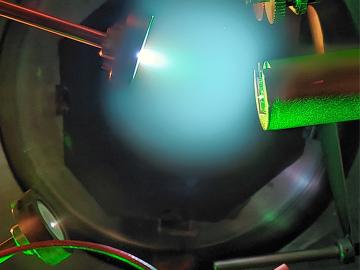
Filter News
Area of Research
- Advanced Manufacturing (4)
- Biology and Environment (11)
- Computational Biology (1)
- Computational Engineering (1)
- Computer Science (6)
- Electricity and Smart Grid (1)
- Energy Science (33)
- Fusion and Fission (1)
- Fusion Energy (2)
- Isotopes (4)
- Materials (26)
- Materials for Computing (6)
- National Security (5)
- Neutron Science (6)
- Nuclear Science and Technology (1)
- Quantum information Science (1)
- Sensors and Controls (1)
- Supercomputing (5)
- Transportation Systems (1)
News Type
News Topics
- (-) Artificial Intelligence (25)
- (-) Biomedical (24)
- (-) Grid (29)
- (-) Materials Science (49)
- (-) Statistics (1)
- 3-D Printing/Advanced Manufacturing (47)
- Advanced Reactors (15)
- Big Data (29)
- Bioenergy (40)
- Biology (48)
- Biotechnology (11)
- Buildings (31)
- Chemical Sciences (22)
- Clean Water (21)
- Composites (14)
- Computer Science (56)
- Coronavirus (17)
- Critical Materials (14)
- Cybersecurity (9)
- Emergency (1)
- Energy Storage (45)
- Environment (88)
- Exascale Computing (4)
- Fossil Energy (1)
- Frontier (4)
- Fusion (18)
- High-Performance Computing (23)
- Hydropower (8)
- Irradiation (2)
- Isotopes (18)
- ITER (4)
- Machine Learning (24)
- Materials (45)
- Mathematics (8)
- Mercury (7)
- Microscopy (22)
- Molten Salt (5)
- Nanotechnology (18)
- National Security (20)
- Neutron Science (37)
- Nuclear Energy (35)
- Partnerships (4)
- Physics (20)
- Polymers (15)
- Quantum Computing (6)
- Quantum Science (16)
- Security (8)
- Simulation (17)
- Space Exploration (10)
- Summit (10)
- Transportation (48)
Media Contacts

The Advanced Plant Phenotyping Laboratory at ORNL utilizes robotics, multi-modal imaging, and AI to enhance understanding of plant genetics and interactions with microbes. It aims to connect genes to traits for advancements in bioenergy, agriculture, and climate resilience. Senior scientist Larry York highlights the lab's capabilities and the insights from a new digital underground imaging system to improve biomass feedstocks for bioenergy and carbon storage.

Distinguished materials scientist Takeshi Egami has spent his career revealing the complex atomic structure of metallic glass and other liquids — sometimes sharing theories with initially resistant minds in the scientific community.

In a game-changing study, ORNL scientists developed a deep learning model — a type of artificial intelligence that mimics human brain function — to analyze high-speed videos of plasma plumes during a process called pulsed laser deposition.
After retiring from Y-12, Scott Abston joined the Isotope Science and Engineering Directorate to support isotope production and work with his former manager. He now leads a team maintaining critical equipment for medical and space applications. Abston finds fulfillment in mentoring his team and is pleased with his decision to continue working.

As a mechanical engineer in building envelope materials research at ORNL, Bryan Maldonado sees opportunities to apply his scientific expertise virtually everywhere he goes, from coast to coast. As an expert in understanding how complex systems operate, he’s using machine learning methods to control the process and ultimately optimize performance.

Jeremiah Sewell leads a team at ORNL, working on xenon-129 production for lung imaging. Reflecting on his career, Sewell views each opportunity as a "door" he steps through, leveraging over 25 years of experience in nuclear power and centrifuge operations to advance the facility’s mission.

Debjani Singh, a senior scientist at ORNL, leads the HydroSource project, which enhances hydropower research by making water data more accessible and useful. With a background in water resources, data science, and earth science, Singh applies innovative tools like AI to advance research. Her career, shaped by her early exposure to science in India, focuses on bridging research with practical applications.

Brian Sanders is focused on impactful, multidisciplinary science at Oak Ridge National Laboratory, developing solutions for everything from improved imaging of plant-microbe interactions that influence ecosystem health to advancing new treatments for cancer and viral infections.

Researchers at Oak Ridge National Laboratory have opened a new virtual library where visitors can check out waveforms instead of books. So far, more than 350 users worldwide have utilized the library, which provides vital understanding of an increasingly complex grid.

Oak Ridge National Laboratory scientists have developed a method leveraging artificial intelligence to accelerate the identification of environmentally friendly solvents for industrial carbon capture, biomass processing, rechargeable batteries and other applications.


